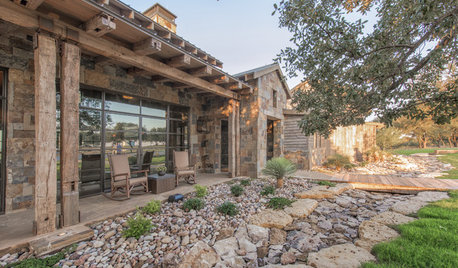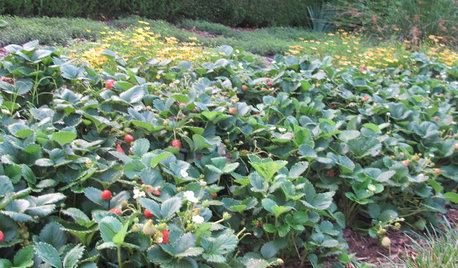Mycorrhizal fungi supplement?
rouge21_gw (CDN Z5b/6a)
11 years ago
Featured Answer
Sort by:Oldest
Comments (45)
ericwi
11 years agorhizo_1 (North AL) zone 7
11 years agoRelated Discussions
mycorrhizal fungi
Comments (28)Now - this may be hijacking the thread, and going far astray from roses, but the question is about how farmers can plant without plowing - so here goes - My mother lives on a farm in Ohio, and the farmers there have been growing grain "no till" for a decade. At planting time, they just draw blades through the soil and drop the seed into the opening. This approach is possible through use of "Roundup Ready" hybrids, which have been genetically engineered to resist Roundup, which is sprayed on the fields to control weeds. Wikipedia says that 87% of USA soy crop was Roundup Ready in 2005. The most progressive farmer that I know told me that when he drives into his fields today, the ground is bumpy due to the earthworm tunnels right at the surface. He said that in the days of deep tilling, there were never any worms. The main objectives have been to save cost, of course, and to save topsoil, which blows away with the traditional fall plowing and spring tilling. I need to ask if they are aware of microbes and how that affects what they are doing. I'm not going to get into the pros and cons of Roundup - that REALLY would be off topic! Anita...See MoreQuestions About Mycorrhizal Fungi
Comments (11)Here is a little interesting blurb I found on the Chill Out! Roses website....an article on Jeff Lowenfels...he has written a book, 'Teaming With Microbes' and articles written about how his grandfather had used this theory to fertilize.....rather interesting.... ...."An oversimplified, nutshell explanation is that root systems produce exudates and carbohydrates that attract fungus and bacteria, and while they're down there dining away, the joke's on them. "They're the bottom of the food chain," Lowenfels explains. "They get eaten, and the things that eat them poop out excess nitrogen and feed the plant right in the root zone. "That's how trees get fertilized. Not Miracle Gro. Not MagAmp -- you know what I mean? So, ha! I never knew that." That's because until recently, soil researchers couldn't see what was going on down there, he said. Lowenfels' Miracle Gro days were over -- because chemical fertilizers contain salts that suck all the water out of these beneficial, simple cellular structures and kill them. "I was so embarrassed," he said. "I couldn't believe I had been writing about gardening for as long as I had and had never heard of half these words." Words like "mycorrhizal," "hyphae" and "vascular arbuscular." Judith...See Moremycorrhizal fungi? Does anyone use?
Comments (14)Yeah, you would get the most benefit from these beneficial organisms if they were planted in the ground but I would definitely say that they would do better with these organisms than without. Many of the bacterial and fungal species out there inhibit the growth of detrimental species of bac and fungi. I've personally noticed that my dragonfruit stopped showing bact/fungal blotches on the new growth about 6months-1 yr after I innoculated. andrew, the vitamin B-1 is known to help with transplant shock. From personal experience, when I get a new plant in, I put it in intensive care and water generously and give it no fertilizers except maybe the B-1 at half strength. With new plants, I just want them to recover first. I always keep new plants in a sheltered place, you don't want to shock it with extreme cold/heat/wind/drought. After a couple weeks to several months of recovering/conditioning for the outdoors, I will finally plant into the ground. When planting into the ground, I like to water frequently, especially for Mango trees, while the tree is adapting to its new life in the ground and extending its roots....See Moreresearch paper - Arbuscular mycorrhizal fungi
Comments (2)Thanks Henry. I like that this article gives an easy to understand summary :-)...See Morerouge21_gw (CDN Z5b/6a)
11 years agoUser
11 years agogardengal48 (PNW Z8/9)
11 years agorosiew
11 years agorouge21_gw (CDN Z5b/6a)
11 years agoKimmsr
11 years agorosiew
11 years agorouge21_gw (CDN Z5b/6a)
11 years agorosiew
11 years agorouge21_gw (CDN Z5b/6a)
11 years agohortster
11 years agorouge21_gw (CDN Z5b/6a)
11 years agoKimmsr
11 years agohortster
11 years agoericwi
11 years agonovascapes
11 years agogardengal48 (PNW Z8/9)
11 years agonovascapes
11 years agogardengal48 (PNW Z8/9)
11 years agoKimmsr
11 years agonovascapes
11 years agorhizo_1 (North AL) zone 7
11 years agoTheMasterGardener1
11 years agogardengal48 (PNW Z8/9)
11 years agonovascapes
11 years agoKimmsr
11 years agonovascapes
11 years agotoxcrusadr
11 years agoKimmsr
11 years agonovascapes
11 years agoalbert_135 39.17°N 119.76°W 4695ft.
11 years agotoxcrusadr
11 years agoKimmsr
11 years agorouge21_gw (CDN Z5b/6a)
11 years agonovascapes
11 years agorouge21_gw (CDN Z5b/6a)
11 years agokimmq
9 years agolast modified: 9 years agotoxcrusadr
9 years agokris2082
9 years agokimmq
9 years agoUser
9 years agokris2082
9 years ago
Related Stories

GARDENING GUIDESNew Ways to Think About All That Mulch in the Garden
Before you go making a mountain out of a mulch hill, learn the facts about what your plants and soil really want
Full Story
GARDENING GUIDESHow to Switch to an Organic Landscape Plan
Ditch the chemicals for a naturally beautiful lawn and garden, using living fertilizers and other nontoxic treatments
Full Story
GARDENING GUIDESGardening Solutions for Heavy Clay Soils
What’s a gardener to do with soil that’s easily compacted and has poor drainage? Find out here
Full Story
LANDSCAPE DESIGNTo Manage Stormwater Sustainably, Understand Your Site
Follow this guide to learn how water moves through your landscape and how best to manage it
Full Story
GARDENING GUIDES15 Ideas to Try in Your Garden This Year
These gardening stories were tops among Houzz readers. Which ideas might you try this year?
Full Story
EDIBLE GARDENSSummer Crops: How to Grow Tomatoes
Plant tomato seedlings in spring for one of the best tastes of summer, fresh from your backyard
Full Story
REGIONAL GARDEN GUIDESSoutheast Gardener's September Checklist
Fertilize strawberries, plant a tree or two and beckon hummingbirds to your Southern garden this month
Full Story



texasbackyardgardener